Can we get back on track now, please?
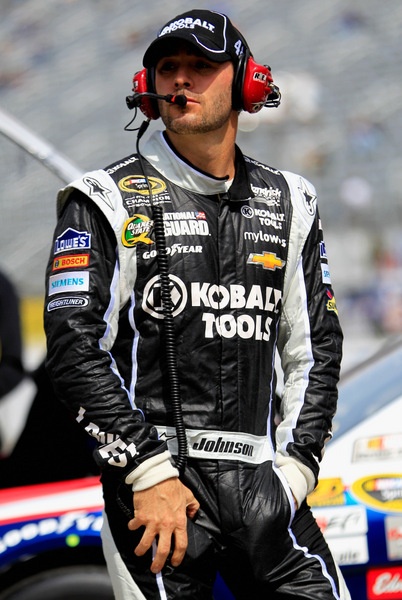
Uh-oh: Jimmie Johnson, on the path toward another championship. Hey, dude, take a week off. Your rivals need a break. (Photo: Getty Images for NASCAR)
By Mike Mulhern
mikemulhern.net
BRISTOL, Tenn.
Jimmie Six-Time?
Maybe his rivals can get him back on a California surfboard...in some shark-infested waters.
Actually Jimmie Johnson could afford to take a week off from this sport and Ski Tahoe or Dive Kona, and still show up the following week points ahead of title rivals Kyle Busch, Tony Stewart and Kevin Harvick.
Uh-oh.
Just three races in and Mr. Five-Time has that much of a lead already? Remember he's renowned for his fast finishes to a season, not his fast starts.
Looks like Busch, on the pole for Sunday's Food City 500 (1 p.m. ET), at record speed (on tires used here last August, a good baseline), has some catching up to do, along with Stewart and Harvick.
And Busch is always a top runner here.
If past here is prologue, this should be the finishing order Sunday evening: Kyle Busch, Jeff Gordon, Matt Kenseth, Brad Keselowski, Greg Biffle, Jimmie Johnson, Kurt Busch, Denny Hamlin, Kevin Harvick, and Carl Edwards.
However, Kasey Kahne appears the man with the best shot at upsetting Kyle Busch here.
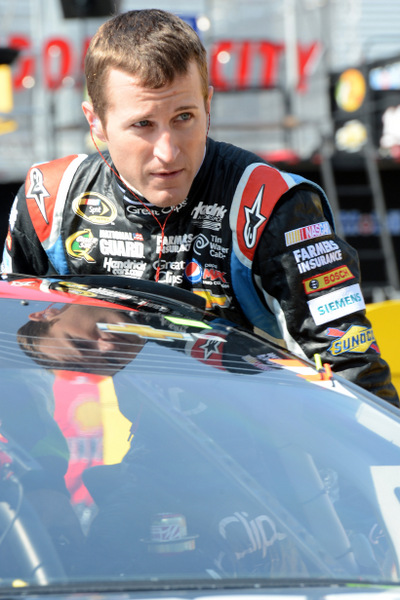
Kasey Kahne: can he beat Kyle Busch Sunday at Bristol? (Photo: Getty Images for NASCAR)
Now we predicted, back in January after touring stock car racing shops on the Charlotte Media Tour, before any driver had turned a real wheel, that Rick Hendrick's guys would kick off the season in high form.
Hardly going out on a limb, of course.
Still, with these new 2013s, it was quite likely that one or two teams could find the first magic trick ahead of the rest.
And it was also clear, after January talks with various team leaders around North Carolina, that logistics and production/inventory would also likely be a big factor in early season success. i.e., Don't crash a lot of cars.
Three races in, what do we have?
Daytona, a low-downforce, high-speed track.
Phoenix, a tight, fast, high-downforce track.
Las Vegas, a big/intermediate, high-downforce, high-speed track.
Now Bristol, a wide, brutal, high-banked short-track.
Now imagine you're one of these crewmen, not only trying to build inventory but also trying learn what-all these brand new cars really want, under those glistening Detroit-styling-cues bodies.
Throw in two maddening weeks at Daytona prepping for the biggest race/races of the season, right out of the box....add a cross-country sprint to Phoenix/Las Vegas...a cross-country sprint back to Tennessee....and looking forward to yet another cross-country sprint this week to Los Angeles, followed by yet another cross-country sprint from California back to Martinsville, Va....with Fort Worth, Texas and Kansas City, Kansas next up.
Are you sure you want this job, this lifestyle?
No wonder some of these guys in this deafening infield garage are sour and grumpy.
Don't even mention rain.
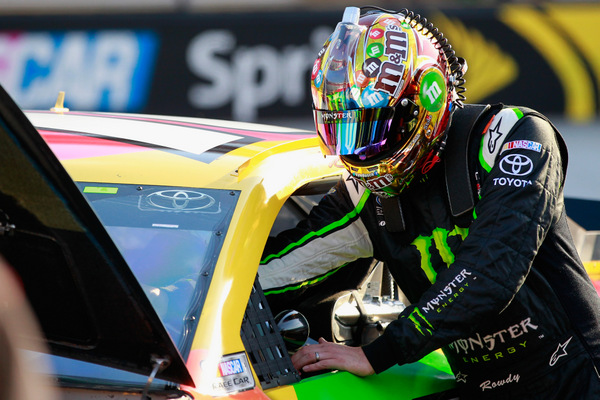
The Candyman: Somehow 'Monster' seems to fit Kyle Busch better (Photo: Getty Images for NASCAR)
Sizing all things up, keeping score, here are two charts to consider, as the new Sprint Cup season opens:
-- Over the five years since Toyota's first NASCAR Sprint Cup win (spring 2008), how's the balance of power on the Cup tour look?
Dodge, 20 wins.
Ford, 32 wins.
Toyota, 50 wins.
Chevrolet, 81 wins.
-- This season so far:
Sprint Cup multi-team owners' average finishes
(through three races)
1. Rick Hendrick (Chevrolet)
four drivers, together average finish: 11.15
2. Roger Penske (Ford)
two drivers, average finish: 11.3
3. Jack Roush (Ford)
three drivers, average finish: 13.8
4. Joe Gibbs (Toyota)
three drivers, average finish: 15.3
5. Michael Waltrip (Toyota)
three drivers, average finish: 16.7
6. Richard Childress (Chevrolet)
four drivers, average finish: 21.3
7. Chip Ganassi (Chevrolet)
two drivers, average finish: 22.8
8. Tony Stewart (Chevrolet)
three drivers, average finish: 24.7
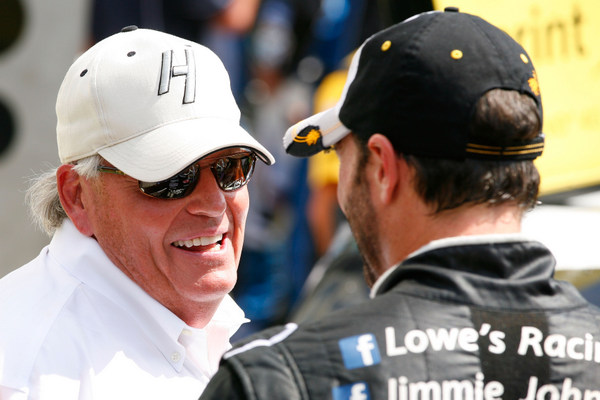
Rick Hendrick: top car owner in NASCAR so far in 2013. (Photo: Getty Images for NASCAR)
Oh, and did we mention the tires?
Big Goodyear tire tests are coming up in April. And as one big tire company likes to say 'The right tire changes everything....'
Goodyear has been coming to tracks so far with generally conservative tires, and Goodyear has been under heavy pressure to come with 'softer' tires. Changing the tire setup of course can significantly alter the chassis setup. So much of the note work done so far on these chassis could be headed for the dumpster.
Oh, and have we pointed out the worries among engine builders that a new horsepower-cutting/speed-cutting rule may be coming?
Some engine builders say they're worried...while some crew chiefs say 'Bring it on.'
The theory here isn't new -- slower speeds, better racing. Less dependence on aerodynamics and more on mechanical grip. Less of an advantage for running in clean air. All that should logically lead to more passing.
Here's one top Sprint Cup crew chief: "The Trucks and Nationwide cars, which both use engines with (speed-cutting) tapered-spacers, put on great shows, and they've got 200 less horsepower than we do. Nationwide cars are 150 pounds heavier than Cup cars, and Nationwide cars are faster in the middle of the corners than Cup cars."
And all three series run the same tires each weekend.
NASCAR's Charlotte Motor Speedway test of such speed-cutting engines in Sprint Cup cars several weeks ago showed corner-entry speeds down some 13 mph, and mid-corner speeds up six mph.
If NASCAR were to throw that engine setup at Cup teams for California -- it's cheap, since it's just a piece of aluminum plate, in a design that has been used for several years now in the Truck and Nationwide series -- crews say "We already know what to do."
But then maybe cutting horsepower may be more of a PR issue for NASCAR than a technical issue....and we all know the problems in NASCAR's PR operation at the moment....
It's been 20 years now since legendary engine man Robert Yates first told NASCAR it's time to cut horsepower. (Photo: Getty Images for NASCAR)
Here's the background, and it may sound like a broken record:
Robert Yates, that legendary engine building genius, told NASCAR nearly 20 years ago that it was time to downsize these 358s and cut horsepower. That was back when a monster motor was maybe 750 horsepower.
Now Sprint Cup engines are 900 horsepower behemoths...continuing the long-standing philosophy that NASCAR stockers are over-horsepower and under-tired.
(Consider this for a little comparison: The new Corvette ZR1 V8 (378 c.i.) puts out 638 street horsepower, one of the most powerful production engines on the road today. And that Camaro Jeff Gordon thrilled that Chevy dealer with the other day Here packs a 580-horsepower engine.)
Do NASCAR stockers really need 900 horsepower? Does speed make for better racing?
There's a good argument there. Probably a good fight or two too.
Engine men here say they don't expect any speed-cutting rules for the California 400, because NASCAR typically gives them at least a week's warning.
However if nothing happens between now and next Sunday, the corner entry speeds at two-mile California's Auto Club Speedway, into those relatively flat 14-degree turns, should be flat awesome. And the racing, not so much so. Corner speeds at the California track have been a major factor there in that track's now infamous single-file NASCAR racing.
Drivers says they were hitting 210 mph into the corners last weekend at Las Vegas Motor Speedway, and that's just a 1-1/2-mile track.
Corner entry speeds at Michigan, a higher-banked track than California, though similar two-mile D-shape, reached 218 mph on the new asphalt there last summer.
"The fans in the stands don't care if we've got 700 horsepower, 800 horsepower, 900 horsepower, or 1,000 horsepower. They just want to see a good race."
That was Doug Yates. In the spring of 2009.
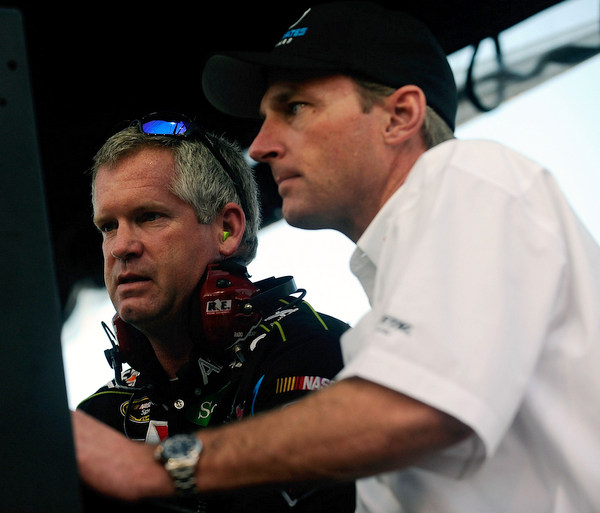
Doug Yates (R), son of Hall of Famer Robert Yates, added his voice to a call to cut horsepower....some four years ago. Is it finally time? (Photo: Getty Images for NASCAR)
© 2010-2011 www.mikemulhern.net All rights reserved.
Web site by www.webdesigncarolinas.com







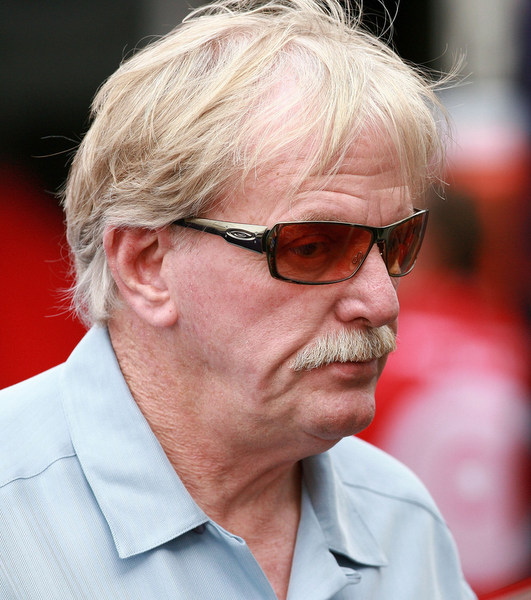
Cut HP and Add Raw Drag
Why NASCAR has hesitated to mandate the tapered spacer for Cup remains baffling. Also needed is the roof blade and the wicker on top of the rear spoiler - they add drag and help slow the cars further and can make the draft work again.
there is no way the manufacturers will allow a
there is no way the manufacturers will allow a roof wicker after pushing NASCAR to remove visible hood hinges, embed the tether plates in the hood, and move to clear lexan shark fins in the pursuit of better identity to the street car.
Denn Hamlin
I believe I wroye a post in here the other day and would like to be able to pass it on in facebook, I talked to Jimmy Ferlito and he mentioned you were in the same frame of mind about Nascar as I am. Is there a way you could check back and see if it was this site my post was. The problem was when I posted it I couldn't find any posts or mine and was wondering how a site can have ideas posted if no one gets to view them I thank you
Post new comment